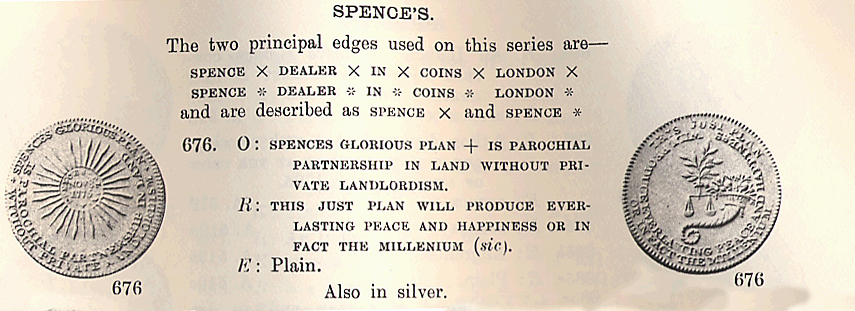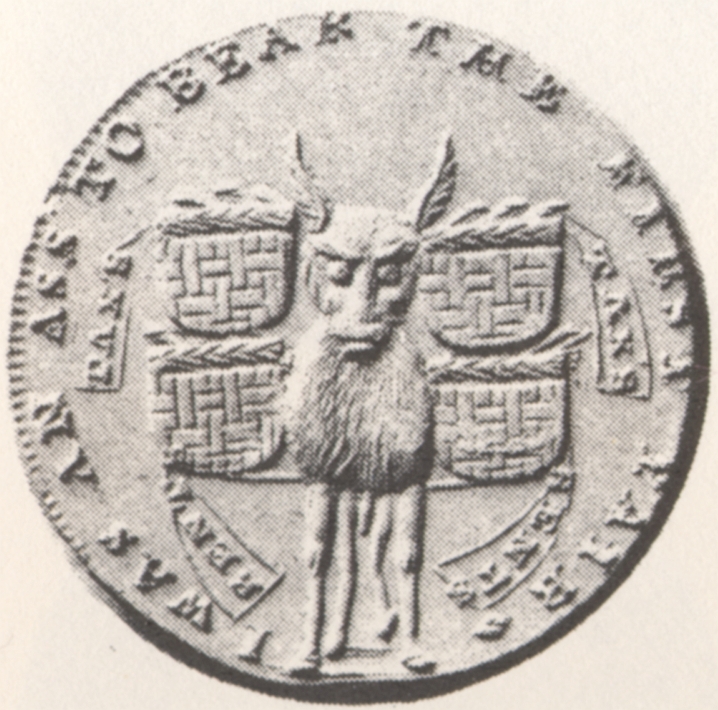.jpg)
Bust of Thomas Spence left on one of his own copper halfpenny tokens, celebrating his imprisonment for sedition in 1794, CM.BI.1915-R (double size image)
.jpg)
Bust of Thomas Spence left on one of his own copper halfpenny tokens, celebrating his imprisonment for sedition in 1794, CM.BI.1915-R (double size image)
The chief user of tokens as propaganda for the revolution was Thomas Spence. His radicalism was of a different stamp to that of many other agitators. Born in Newcastle in 1750, by his mid-twenties he was already politically active, and had developed a plan for land reform that would have seen the communalisation of all landed property and the abolition of landlords and rents. He had published this already in 1775 as Property in Land: Every One's Right but, losing nothing to political fashion, republished it under the title The Real Rights of Man in 1793 (an online text can be found here). He was, despite the title, a keen advocate of Paine's work, which he sold at the London shop he ran by 1794 (when he was briefly imprisoned for its output), and lost no opportunity to associate himself with the 'other Thomas', but it is doubtful that Paine would have agreed with his more communist ideas.

Catalogue entry for Spence's first token commemorating his 1775 publication of his Plan
The obverse of the farthing at left below lists Spence as the first of three Thomases, 'Advocates of the Rights of Man', the others being More and Paine; the reverse at right advertises Spence's penny weekly publication, Pig's Meat, the title of which played upon a reference of Edmund Burke's to 'the swinish multitude'.
.jpg)
|
.jpg)
|
From the first Spence was alert to the possibilities of tokens as propaganda, and his earliest issue commemorating the 1775 publication of his Plan appears to have predated the 'token mania' by some years and is consequently extremely rare. Once established in London, however, he found not only a ready market, better than for his bookseller's business, but also a fruitful collaboration with the engraver James, whose readiness to depict Spence's ideas in his animated and vivid style led to a riot of high-impact political imagery which much outpaces Spence's rather turgid prose in the communication of not just his politics but his sense of outrage and rebellion. The result has been a kind of immortality that Spence might not, perhaps have wished, compared to the relative obscurity of his actual writings, but which one of his own catalogues shows that he probably expected:
"... some of them on account of device, some for neatness of workmanship, and all on account of their great variety, may, nay will claim the attention of the curious in after-ages."
.jpg) (Reverse of a copper halfpenny token of Thomas Spence, late eighteenth century, CM.BI.1924-R) |
.jpg) (Obverse of a copper halfpenny token of Thomas Spence, 1795, Trinity College Collection, CM.TR.1385-R) |
At their best Spence's designs displayed outspoken idealism matched with a heavy irony about the present day's injustices. Here the token at left forecasts 'The End of Oppression', with revolutionaries attending a bonfire of land charters, while that at right depicts a citizen being seized by the press-gang for naval service, under the legend 'British Liberty Displayed'.
 (Catalogue image of one of Spence's earlier tokens) |
.jpg) (Reverse of a copper halfpenny token of Thomas Spence, late eighteenth century, CM.BI.1917-R) |
As might be expected from his planned return to a primitive commonwealth, Spence's ideas about the rights of man stemmed from an idea that in his natural condition man had been to use land as he liked with no-one able to claim ownership of it. Spence saw rents and taxes as later and immoral burdens on this essential liberty, and used arresting images, sometimes likewise over-burdened with his own rhetoric, to make these points. In the pair above, at the left an ass laden with two sets of panniers, the lower pair labelled "Rents" and the upper "Tax's", proclaims in the legend, "I was an Ass to Bear the First Pair"; at the right, an American Indian with bow and tomahawk is associated with the legend, "If rents I once consent to pay, my liberty is past away". Both of these pieces refer to engravings that Spence published in the course of 1796, and quote only parts of those works' texts.
.jpg) (Obverse of a copper farthing token of Thomas Spence, late eighteenth century, Trinity College Collection, CM.TR.1451-R) |
.jpg) (Reverse of a copper halfpenny token of Thomas Spence, late eighteenth century, CM.BI.1919-R) |
Similarly utopian views are evident in these tokens, the farthing at left showing Adam and Eve in Eden embracing with the legend "Man over Man Made He not Lord", and the halfpenny at right for once using no words, but merely depicting a shepherd at repose in a gorgeous English countryside, a feat of engraving for which James received the congratulation of many repeat commissions, from Spence and others, for the design.
Many of Spence's designs worked by pairing opposites or contrasts as obverse and reverse, or even within a design or legend, a device which allowed his bitter but sharply satirical wit full play. The first pair also illustrates that in the eternal struggle between 'cat persons' and 'dog persons', Spence sided with the cats... At left, a dog with paw raised in supplication is paired with the legend "Much Gratitude Brings Servitude" whereas at right a cat is made to declare "I Among Slaves Enjoy My Freedom".
.jpg)
|
.jpg)
|
Sometimes Spence and James eschewed subtlety for powerful images and slogans. Again, it is the artistry of James in giving life to Spence's imagination that makes these pieces stand out, rather than the originality of Spence's sentiment.
.jpg)
|
.jpg)
|
Here a paired set of images show an emaciated man in gaol gnawing a bone under the legend 'Before the Revolution' contrasted with three men dancing and another at lunch beneath a tree under the legend 'After the Revolution'.
For all his revolutionary fervour, for the most part Spence was also a patriot. He wanted to change England almost entirely, but still thought the English better off than the French. This pairing neatly illustrates his feelings on the matter, and the clarity with which he occasionally displayed whose side he was on in the war may have saved him from actual trial. In this, as with much else, the difference between Spence and Paine could not be clearer.
.jpg)
|
.jpg)
|
The former piece above shows a fat man eating a fine dinner with the legend 'English Slavery' and the latter a thin man in tricorned hat gnawing a bone on a folded blanket before a grate, under the legend 'French Liberty'.
However, Spence's urgency for change could sometimes boil over into genuine hatred, and for this as much as his pretensions to parity with Paine, his efforts were countered by matching issues of his opponents...
Go back | Continue